
“The first mistake of art is to assume that it’s serious.” -Lester Bangs
Last night we braved the rain and bad signage in Lincoln, Massachusetts to hear a conversation with the artist Laylah Ali and Assistant Curator Dina Deitsch at the Decordova Museum and Sculpture Park. The evening was billed as a conversation on the reemergence of drawing and Ali’s new work. But with a breezy acknowledgement by the artist that she had “always drawn,” the talk centered on the always fascinating but elusive subject matter of Ali’s latest “note drawings.”
Inspired by sources such as NPR, John Brown biographies, and the dalliances of lovers outside her studio window (who knew Western Mass was so saucy?!), the “note drawings” feel more personal, more intimate, as if we are witness to the subconscious thoughts of the artist. Ali is creating form out of the minutiae of modern daily life, while still leaving room for interpretation. “The dynamic is similar (to earlier work) in that the viewer still has to make choices and name things,” said Ali. One surprising aspect of this new work is how unmediated it is by Ali; these notes are truly random, and the drawing has a spontaneous nature and quality. The artist spoke of learning to trust her instincts more, as her earlier work was quite deliberate in planning and execution. In assigning race and gender to her characters in this new work, Ali still manages to deftly subvert the viewers assumptions about race and identity, and complicates those questions further by revealing more.
The conversation got interesting as it steered towards the questions of sex and identity. Ali spoke of a hunger in contemporary art for grotesque black female bodies, and feels audiences are not as comfortable with white mutilated bodies. She also spoke of a sort of double standard that still exists in contemporary art, that male artists “who traffic in the female figure” are usually only discussed in terms of “ownership” and “desire.” I thought about the historical and social baggage that must come with being a black female artist—if we were discussing John Currin’s work, would the same issues of race and identity come up? And why does the white female figure become the generic female? One of Ali’s “note drawings” featured a blonde perky character, whose breasts were exposed through careful cutouts of her striped shirt. She reminded me of a typical advertisement I might have seen in a teen magazine growing up, the embodiment of youth, beauty and blossoming sexuality. But any meaning assigned to it is purely my own, as the accompanying text is random, appearing in and out of the lines and patterns of the drawing.